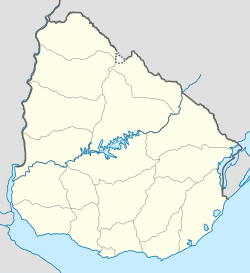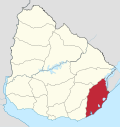Chuy
Chuy | |
|---|---|
City | |
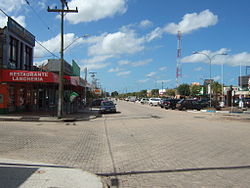 | |
| Coordinates:33°41′47″S53°27′36″W/ 33.69639°S 53.46000°W | |
| Country | |
| Department | |
| Elevation | 13 m (43 ft) |
| Population (2011 Census) | |
| • Total | 9,675 |
| Time zone | UTC−3 |
| Postal code | 27100 |
| Dial plan | +598 4474 (+4 digits) |
| Climate | Cfa |
Chuy(Spanish pronunciation:[ˈtʃwi]) is a city in the extreme east ofUruguay,in theRocha Department,340 kilometres (211 mi) northeast ofMontevideo.[1]It lies on the border withBrazil,separated from its Brazilian sister town ofChuíonly by a shared avenue that serves as the border, and by theArroyo Chuy(stream) to the east. Chuy's population was 9,675 in 2011.[2]
Etymology
[edit]The word "Chuy", according to most scholars, comes from theTupi–Guarani language.The Indians had designated the small brook on whose banks the town would emerge with the same name. According toDaniel Granada,"Chui" was also the name the Indians gave a yellow-breasted bird, native and common in the marshes of the area. According toTancredo Blotta,chuyis a compound word which should be translated as "river of brown water".[3]
The Brazilian historianPéricles Azambujaalludes to a rumor that the word (originallyChyu) would have been brought by former tribes who migrated from theAndes.A Quechua word,achuyhad the meaning of "teaching" through storytelling, thuschuy'owould be "master" or "narrator." In a different context,chuycan be seen to mean a small frog or toad in the water, a small turtle or small horse. Advocates of some of these theories base their beliefs on the fact that the stream, and watercourse, is insignificant compared to others in the area.[3]
History
[edit]In the late 17th century, Portugal and Spain began the occupation of theBanda Oriental;they succeeded in foundingColonia del Sacramentoin 1680,Montevideoin 1726, theFuerte de San Miguelin 1737, and theFortaleza de Santa Teresain 1762. TheTreaty of Madrid (1750)settled boundaries between the mouth of the creek Valizas and Cabo Polonio.[4]By order of the Governor of Montevideo,José Joaquín de Viana,in 1751, frontier military posts were created, with colonial guards on both sides of the Chuy stream, the result of the discussions that had prevailed in the courts of the Spanish and Portuguese crowns. The treaty expired in 1761 with the signing of theTreaty of El Pardo.In Europe came theSeven Years' War.At that time,Pedro de Cevallosousted the Portuguese colony ofSanta Teresa and San Miguel,and Chuy came to dominate the southern Rio Grande do Sul. The situation was unstable, however, and the signing of theTreaty of San Ildefonsoon October 1, 1777, led to a clearer demarcation of dominions in South America.[5]
In 1762 after the surrender of Colonia del Sacramento, Pedro de Cevallos went to the Portuguese, demanding the "eviction of theYacuí Riverand areas of Rio Pardo, Santo Amaro, Rio Grande, San Gonzalo, San Miguel and Chuy, as well asMartín García IslandandDos Hermanas Island."In 1763, the Military Command atMaldonadowas created to take care of security in the east.[6]In 1772Bernardo Lecocqdeveloped the fortifications of Fuerte de San Miguel here.[7]Eventually, however, Spain would lose influence over these territories.
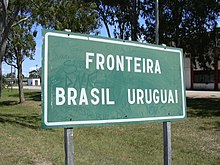
For the sake of demarcating the Hispano-Lusitanian boundary, both Spain and Portugal brought to the area a significant number of scientists. Work in the Guardia de Chuy began in February 1784.[8] It is presumed that in 1826, there was a farmhouse in Chuy, asLeonardo Oliveraafter the famousSableada del Chuy,on the first day of the year, he wrote that it was a surprise to Brazilians, "leaving over twenty dead behind, as I mentioned to Your Excellency, I left a captain and a wounded soldier in a house of Chuy, not knowing where to take them, so that a certain family would take care of their wounds." The 1861 map of the area byEmilio Laviñaincludes a ranch, stalls and a store belonging to the firm Peyre Seijo & Co. In addition to this general trade store, there existed a chemist and a teacher named Marcelino Villazuso, who gave private lessons for many years. The growing importance of this border and the existence of military posts on the Brazilian side, prompted the authorities to install a police station orComandancia de Fronteradepending on Maldonado in 1872.

In 1888, the town was recognized as such by the department. The Economic Administrative Board Rocha urged neighbours to form a Neighbourhood Commission (first authorities to address local issues), and these were grouped immediately notifying the Honourable Board Rocha.
Uruguay and Brazil inherited differences resulting from the ongoing litigation, which would be amended in repeated boundary treaties with the placement of boundary markers in the twentieth century. On 7 May 1913, a convention was signed to amend the limit on the San Miguel river.[9]On 20 December 1933 a Legal Status of Border was established and on 21 July 1972 bilateral notices were exchanged about the waterfront borders at the height of the mouth of the creek Chuy.[10][11]
On 14 January 1938, the status of Chui was elevated to "Pueblo" (village) by the Act of Ley Nº 9.758.[12]On 29 June 1961, it was elevated to "Villa" (town) by the Act of Ley Nº 12.887,[13]and on 11 December 1981, it was further elevated to "Ciudad" (city) by the Act of Ley Nº 15.227.[14]
Geography
[edit]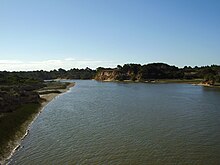
The town lies onNational Route 9,340 kilometres northeast of the capital,Montevideo,[1]and only a few feet from Brazil's Route BR 471. Chuy is only 15 km from the Atlantic Ocean, and in the northern hinterland is located a similar distance from theLagoa Mirim.[citation needed]
The BR 471 road in Brazil running from Porto Alegre and Pelotas borders the Chui town and passes through to Uruguay where it becomes Ruta 9. Each country's immigration office is located at the entry to the town. The main street, which is a two-lane road, is known as Avenida Uruguai ( "Uruguay Avenue" ) in Brazil and as it passes to Uruguay, its name changes to Avenida Brasil ( "Brazil Avenue" ). The Brazilian town, Chui, has shops selling clothes, shoes and household goods while on the Uruguayan side, Chuy has duty-free shops and a casino.[15]
Demographics
[edit]Chuy's residents are mostly Uruguayans and Brazilians, with almost all its residents speaking Spanish andUruguayan Portuguese.The council organizes cultural activities jointly with the neighbouring Brazilian town of the same name as the "Carnival Chuy-Chuí Without Borders".
There is a small but significantPalestinian Uruguayanpopulation, mostly Muslims.
Population
[edit]According to the 2011 census, Chui had a population of 9,675.[2]
| Year | Population |
|---|---|
| 1963 | 2,876 |
| 1975 | 4,521 |
| 1985 | 8,257 |
| 1996 | 9,804 |
| 2004 | 10,401 |
| 2011 | 9,675 |
Source:Instituto Nacional de Estadística de Uruguay[16]
Economy
[edit]It is a border city, adjacent to the Brazilian city ofChuí.Both cities share the main avenue which serves as the borderline.[citation needed]Chuy is a relatively thriving centre for trade with the Brazilians and has several shops to cater for tourists. It is not unusual for Uruguayans from theMontevideoarea to make long journeys in order to purchase goods across the border which would cost significantly more at home. Manyduty-free shops[1]offer spirits, cosmetics, clothing, and luxury goods. There is a casino in Uruguay's Chuy,[1]whereas gambling is forbidden on the Brazilian side.
Notable landmarks
[edit]Hotels of note includeHotel Internacional, Chuy;Hotel Alerces;Nuevo Hotel Plaza; and several hostels/apartments.[17]Estadio Samuel Prillaclies in the southeastern part of the town.[citation needed]The town is served byChuy Hospitalin the southern-central part.[citation needed]Another landmark near Chuy is the lighthouse 10 km away near the Barro du Chui inlet. Beaches here are relatively free of crowds, and sea lions can be spotted in the area.[15]
Fuerte San Miguel
[edit]
TheFuerte San Miguel,8 kilometres to the west, was built on top of a hill in 1737 (construction was started in 1734) with a square plan by the Portuguese. The fort, built with large and heavy stones to create the tall towers (four bastions), thick walls and sturdy ramparts to withstand onslaught of wars that were fought against the Spanish invaders was instrumental in Uruguay evolving as an independent nation. It was built in pink granite stones, is surrounded by a moat, and has been fully restored. It is located in the town ofDieciocho de Julio,8 km west of Chui along a winding hill road.[18][19][20]
However, over the years after the independence of Uruguay, the fort's walls started crumbling as it remained untended. The townspeople had the fort restored in 1927, by archaeologist Horacio Arredondo, who had similarly restored another old fort, Santa Teresa. It is now reconstructed with period architectural artefacts. The refurbished fort maintains the old moat with the drawbridge used for access to the fort during wars, and is surrounded by a well-tended garden. As a protected area, the diverse natural ecosystems has also been retained where native wildlife of Monkeys, birds,capybarasandguazubiraare seen in the forests and marshland.[15][19][20]
Under the administration of the Army, the structure is permanently open to visitors, harbouring a Museum of Military History, which highlights the collection of historical uniforms of the garrison, and the sample of the historical evolution of Army uniforms.[20]
Fortaleza de Santa Teresa
[edit]
Fortaleza de Santa Teresawhich was declared a National Historic Monument by Law on December 26, 1927, has rich history of battles. It lies within theParque Nacional de Santa Teresa36 kilometres to the south. The fort erected in October 1762 witnessed many battles for its control. The Portuguese built it in 1762 in anticipation of war with Spain at the La Angostura path to Castillos Chico. Coronel Tomas Luis Onsorio started building the fort. However, construction was stopped in 1763 when Don Pedro de Cevallos Governor from Buenos Aires' captured the forts of Santa Teresa and also San Miguel. Construction of the fort was restarted in 1763 by the Spanish. The fort was built to an irregular pentagon plan with five bastions. It has a perimeter of 942 metres.[21]
In 1797, to maintain law and order in the region, the Veteran Force of Blandengues of the Montevideo Border established in 1796, made it their headquarters. It came under Portuguese control during the Eastern Revolution after the Patriots were defeated. However, in 1812, the Patriots recaptured the Fort to exercise control over the border with Portugal. In 1816, the Portuguese invaded again and captured the fort along with the Eastern Province. The Liberty Crusade recovered it in 1825. In 1826, Coronel Leonardo Olivera of the Patriot Troops captured the fort. Finally, following the signing of the Preliminary Convention of Peace genesis by the Eastern State of Uruguay, and in 1828, with the signing of the Preliminary Convention of Peace agreement by the Eastern State of Uruguay, the Fort's importance declined. It was abandoned. The fort is now part of the San Miguel National Park, named after the fort, covering 3,000 hectares. The fort has been restored and is now major attraction for visitors to the park. The park also provides other attractions such as beautiful beaches and forested areas. The Uruguay army is in charge of the management and maintenance of Santa Teresa.[21][22]It is located 36 kilometres south of Chuy, about 800 metres from the coast atPlaya la Moza.
Consular representation
[edit]Brazilhas a Consulate in Chuy.[23]
Places of worship
[edit]See also
[edit]References
[edit]- ^abcdBurford, Tim (2010).Uruguay.Bradt Travel Guides. p. 242.ISBN978-1-84162-316-0.Retrieved4 June2011.
- ^ab"Censos 2011 Cuadros Rocha".INE. 2012. Archived fromthe originalon 10 October 2012.Retrieved25 August2012.
- ^abDornel, Julio."El topónimo" Chuy "".Uruguay Informe. Archived fromthe originalon 2012-03-16.Retrieved10 June2011.
- ^Bao, Sandra; Clark, Gregor; Symington, Andy; Bridget Gleeson; Lucas Vidgen (1 August 2010).Argentina.Lonely Planet. p. 587.ISBN978-1-74179-464-9.Retrieved8 June2011.
- ^Great Britain. Foreign Office. Historical Section (1973).Peace handbooks.Scholarly Resources. p. 49.ISBN978-0-8420-1704-6.Retrieved10 June2011.
- ^Core, Fernando Aguerre (1 January 2007).Una caída anunciada: el obispo Torre y los jesuitas del Río de la Plata (1757–1773).Librería Linardi y Risso. p. 191.ISBN978-9974-675-03-2.Retrieved8 June2011.
- ^Forte de San MiguelArchived2016-03-04 at theWayback Machineaccessed 10 March 2012
- ^Pintos, Aníbal Barrios (2000).Historia de los pueblos orientales: sus orígenes, procesos fundacionales, sus primeros años.Academia Nacional de Letras.Retrieved8 June2011.
- ^Grub, Ulises Rubens (1951).Evolución histórica geográfica y política de las fronteras del Uruguay con Brasil.Imprenta Nacional.Retrieved8 June2011.
- ^Ambrosi, Luis Alberto Musso (1978).Legislación uruguaya sobre Brasil, 1825–1976.Instituto de Cultura Uruguayo-Brasileño.Retrieved8 June2011.
- ^Zacklin, Ralph (1975).El derecho del mar en evolución: la contribución de los países americanos.Fondo de Cultura Económica. p. 241.Retrieved8 June2011.
- ^"Ley Nº 9.758".República Oriental del Uruguay, Poder Legislativo. 1938. Archived fromthe originalon 28 December 2013.Retrieved7 September2012.
- ^"Ley Nº 12.887".República Oriental del Uruguay, Poder Legislativo. 1961. Archived fromthe originalon 28 December 2013.Retrieved7 September2012.
- ^"Ley Nº 15.227".República Oriental del Uruguay, Poder Legislativo. 1981. Archived fromthe originalon 28 December 2013.Retrieved7 September2012.
- ^abcBen Box; Jane Egginton; Mick Day (31 December 2002).Brazil handbook.Footprint Travel Guides. pp.358–.ISBN978-1-903471-44-9.Retrieved4 June2011.
- ^"Statistics of urban localities (1963–2004)"(PDF).INE. 2012. Archived fromthe original(PDF)on 13 November 2009.Retrieved7 September2012.
- ^"Hoteles".Chuynet.com.Retrieved4 June2011.
- ^Regis St Louis; Sandra Bao; Gregor Clark; Aimee Dowl (3 March 2010).Lonely Planet South America on a Shoestring.Lonely Planet. pp.902–.ISBN978-1-74104-923-7.Retrieved4 June2011.
- ^ab"Explore Uruguay History of the San Miguel Fort in Chuy Uruguay".Explore-Uruguay.com.Retrieved4 June2011.
- ^abc"Museo Militar Fuerte de San Miguel".Archived fromthe originalon 29 June 2011.Retrieved4 June2011.
- ^ab"Fort of Santa Teresa".Uruguay.com. Archived fromthe originalon 2011-08-15.Retrieved4 June2011.
- ^"Santa Teresa Uruguay".Explore-Uruguay.com.Retrieved5 June2011.
- ^"Consulado do Brasil no Chuí".Ministério das Relações Exteriores(in Portuguese).Retrieved13 June2022.

